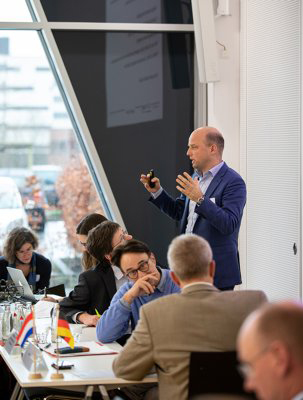Travel time between the two universities is about an hour, and they are complementary in many respects. The University of Twente (UT) and the Münster University (WWU) therefore came together on 13 December to examin the opportunities for intensifying their cooperation. One attractive option is battery research, for next generation sustainable energy storage. Another is offering more joint education programmes. The collaborative research grants, introduced recently, are very popular already.
In several fields, the University of Twente and the Westfälische Wilhelms Universität Münster (WWU) already know to find each other, for example in the double degree Master’s programme Compararive public governance. In research areas like medical imaging and photonics, there is close collaboration. And there are scientists with an appointment at both universities, like Prof Wilfred van der Wiel. Further exploration of the opportunites was the goal of the meeting at 13 December, of the Rectors, Deans, scientific directors and members of staff. WWU is the fifth largest university in Germany, with 45,000 students: a broad university, without engineering disciplines though. The UT is complementary, with both engineering and social disciplines. And it has a proven track record in valorisation and entrepreneurship.
 In Münster, an ‘Excellent Start-up Center’ is currently set up for the North Rhine-Westphalia region, for which the Kennispark ecosystem in Twente serves as a best practice. A strong example of research at both universities, focuses on next generation battery technology. Prof. Mark Huijben (photo), illustrated cooperation opportunities with the recently started research centre MEET (Münster Electrochemical Energy Technology). These include both fundamental and applied research, like studying battery behaviour under extreme circumstances.
In Münster, an ‘Excellent Start-up Center’ is currently set up for the North Rhine-Westphalia region, for which the Kennispark ecosystem in Twente serves as a best practice. A strong example of research at both universities, focuses on next generation battery technology. Prof. Mark Huijben (photo), illustrated cooperation opportunities with the recently started research centre MEET (Münster Electrochemical Energy Technology). These include both fundamental and applied research, like studying battery behaviour under extreme circumstances.
'Overwhelmed'
Joint education can also be intensified, both universities concluded; for example in nano science and technology. Prof Johan Wessels, Rector of WWU, said he was ‘quite overwhelmed’ by all ideas that came forward in several sessions. The willingness is clear: recently, the universities agreed on three joint research grants of 80 thousand euros each. There already are nineteen applicants for this. The different funding systems in The Netherlands and Germany may be a complicating factor in some cases, but collaboration can already start ‘bottom-up’ by sharing the research infrastructure on both sides of the border.
Photos Peter Leßmann





